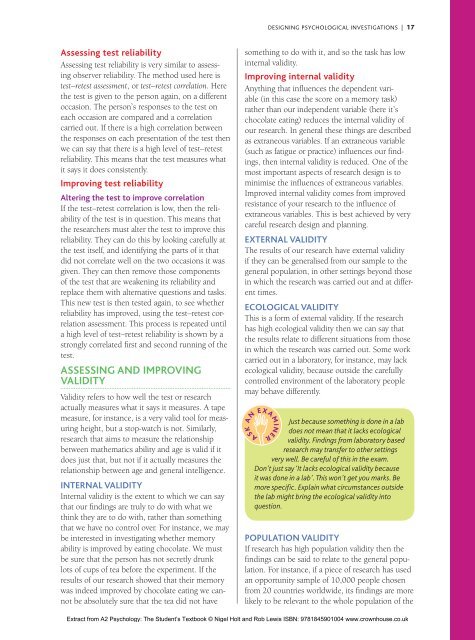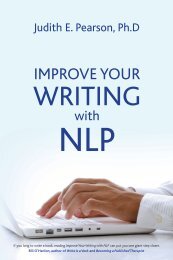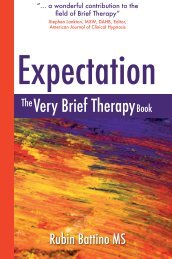Nigel Holt and Rob Lewis - Crown House Publishing.
Nigel Holt and Rob Lewis - Crown House Publishing.
Nigel Holt and Rob Lewis - Crown House Publishing.
You also want an ePaper? Increase the reach of your titles
YUMPU automatically turns print PDFs into web optimized ePapers that Google loves.
DESIGNING PSYCHOLOGICAL INVESTIGATIONS | 17Assessing test reliabilityAssessing test reliability is very similar to assessingobserver reliability. The method used here istest–retest assessment, or test–retest correlation. Herethe test is given to the person again, on a differentoccasion. The person’s responses to the test oneach occasion are compared <strong>and</strong> a correlationcarried out. If there is a high correlation betweenthe responses on each presentation of the test thenwe can say that there is a high level of test–retestreliability. This means that the test measures whatit says it does consistently.Improving test reliabilityAltering the test to improve correlationIf the test–retest correlation is low, then the reliabilityof the test is in question. This means thatthe researchers must alter the test to improve thisreliability. They can do this by looking carefully atthe test itself, <strong>and</strong> identifying the parts of it thatdid not correlate well on the two occasions it wasgiven. They can then remove those componentsof the test that are weakening its reliability <strong>and</strong>replace them with alternative questions <strong>and</strong> tasks.This new test is then tested again, to see whetherreliability has improved, using the test–retest correlationassessment. This process is repeated untila high level of test–retest reliability is shown by astrongly correlated first <strong>and</strong> second running of thetest.Assessing <strong>and</strong> improvingvalidityValidity refers to how well the test or researchactually measures what it says it measures. A tapemeasure, for instance, is a very valid tool for measuringheight, but a stop-watch is not. Similarly,research that aims to measure the relationshipbetween mathematics ability <strong>and</strong> age is valid if itdoes just that, but not if it actually measures therelationship between age <strong>and</strong> general intelligence.Internal validityInternal validity is the extent to which we can saythat our findings are truly to do with what wethink they are to do with, rather than somethingthat we have no control over. For instance, we maybe interested in investigating whether memoryability is improved by eating chocolate. We mustbe sure that the person has not secretly drunklots of cups of tea before the experiment. If theresults of our research showed that their memorywas indeed improved by chocolate eating we cannotbe absolutely sure that the tea did not havesomething to do with it, <strong>and</strong> so the task has lowinternal validity.Improving internal validityAnything that influences the dependent variable(in this case the score on a memory task)rather than our independent variable (here it’schocolate eating) reduces the internal validity ofour research. In general these things are describedas extraneous variables. If an extraneous variable(such as fatigue or practice) influences our findings,then internal validity is reduced. One of themost important aspects of research design is tominimise the influences of extraneous variables.Improved internal validity comes from improvedresistance of your research to the influence ofextraneous variables. This is best achieved by verycareful research design <strong>and</strong> planning.External validityThe results of our research have external validityif they can be generalised from our sample to thegeneral population, in other settings beyond thosein which the research was carried out <strong>and</strong> at differenttimes.Ecological validityThis is a form of external validity. If the researchhas high ecological validity then we can say thatthe results relate to different situations from thosein which the research was carried out. Some workcarried out in a laboratory, for instance, may lackecological validity, because outside the carefullycontrolled environment of the laboratory peoplemay behave differently.Just because something is done in a labdoes not mean that it lacks ecologicalvalidity. Findings from laboratory basedresearch may transfer to other settingsvery well. Be careful of this in the exam.Don’t just say ‘It lacks ecological validity becauseit was done in a lab’. This won’t get you marks. Bemore specific. Explain what circumstances outsidethe lab might bring the ecological validity intoquestion.Population validityIf research has high population validity then thefindings can be said to relate to the general population.For instance, if a piece of research has usedan opportunity sample of 10,000 people chosenfrom 20 countries worldwide, its findings are morelikely to be relevant to the whole population of theExtract from A2 Psychology: The Student’s Textbook © <strong>Nigel</strong> <strong>Holt</strong> <strong>and</strong> <strong>Rob</strong> <strong>Lewis</strong> ISBN: 9781845901004 www.crownhouse.co.uk

















